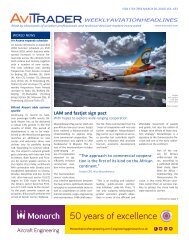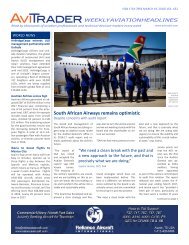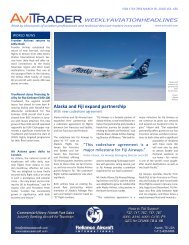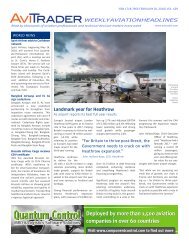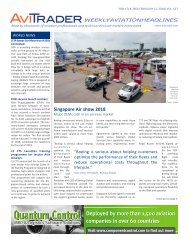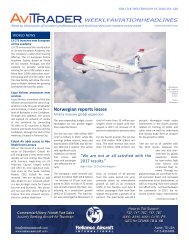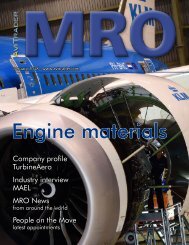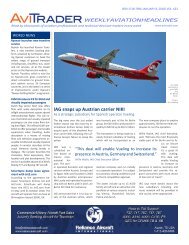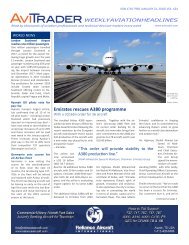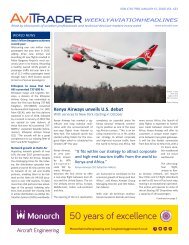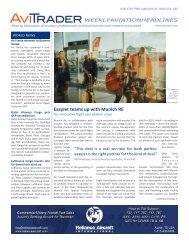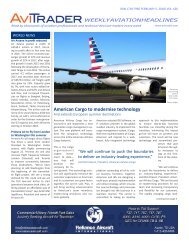AviTrader_Monthly_MRO_e-Magazine_2017-02
AviTrader_Monthly_MRO_e-Magazine_2017-02
AviTrader_Monthly_MRO_e-Magazine_2017-02
You also want an ePaper? Increase the reach of your titles
YUMPU automatically turns print PDFs into web optimized ePapers that Google loves.
Cover story: Aircraft teardowns<br />
15<br />
The valuation of certain components can flactuate rapidly.<br />
heidt is seeing further consolidation of the companies and facilities<br />
offering teardown services. He says this is an indication of a maturing<br />
market which is a great thing as another way to create value within<br />
commercial aviation. “However, the teardown market needs to be<br />
cautious not to get too comfortable. Focus on competitive pricing and<br />
customer service so other alternative entrants don’t take advantage of<br />
an opportunity,” he warns.<br />
“There are so many companies trying to get into the teardown business<br />
that have absolutely no clue what they are doing,” Wooldrik weighs in.<br />
He explains that these companies often do have access to some form<br />
of capital and they start buying airplanes without sufficient knowledge<br />
about the part-out business. “These companies tend to overbid on assets<br />
which in turn drives the prices up.”<br />
However, Wooldrik assures that this issue usually addresses itself because<br />
these companies more often than not fail as they discover sooner<br />
or later that they’ve paid more for the asset than they will ever make<br />
selling the individual parts.<br />
Borchers reckons there should be a standardised framework that unites<br />
operators, leasing companies, <strong>MRO</strong>’s and parts companies on what<br />
to require upon redelivery that will follow the part through its lifecycle.<br />
And there is increasing competition in engine teardown too. Morgan,<br />
with 25 years’ experience in the commercial aircraft engine overhaul<br />
and trading business knows that engines represent the majority of the<br />
aircraft’s aftermarket value and this attracts a lot of part-out companies<br />
to taking on the engine part-out business.<br />
However, Morgan does not recommend anyone getting into the engine<br />
business without adequate technical expertise. He says the numbers<br />
(deal size) are large, but the potential to get hurt is even larger. “You<br />
need to have a very good understanding of the market, hardware<br />
repair and scrap characteristics and customer demand characteristics.<br />
At ASI we have built a team that will be very competitive in the engine<br />
part-out business, with both technical know-how and key customer<br />
relationships the engine business is our strength.”<br />
Engine maintenance is very material intensive. The wave of shop visits<br />
requires an economical source of engine material to avoid the extremely<br />
high costs of new parts, Montreuil relays. “The engine shops<br />
who have sold PBH agreements are highly motivated to acquire used<br />
material that can reduce their shop visit costs. Even if some material<br />
that is required is out of scope of PBH and considered over and above,<br />
or it’s a time and material shop visit, lead times of new material make<br />
sourcing used material more attractive.”<br />
Material is the number one cost driver for engine maintenance. And<br />
as Benscheidt sums up, having an alternative to purchase serviceable<br />
material at a reduced price that will achieve the same end result rather<br />
than new OEM parts is driving the demand and growth in the engine<br />
teardown market.<br />
<strong>AviTrader</strong> <strong>MRO</strong> - February <strong>2017</strong>





